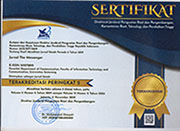Nonverbal Communication Reconstruction on Facebook
Abstract
Facebook provides users comfort in communicating even though they cannot see expressions or any other nonverbal signs, which have been an essential factor in supporting face-to-face communication. Therefore, this research is necessary because the absence of nonverbal communication, especially facial expression, touching, and gesture, renders the communication process between individuals ineffective and uncomfortable, as it was when people first used email to communicate via the internet. Through the study of Computer-Mediated Communication (CMC) perspectives, nonverbal communication, Social Presence Theory and Lack of Social Context Cues theory, this paper will discuss forms of nonverbal communication in the digital era. This study is based on research conducted by researchers using the netnography method and carried out through literature studies. The research was conducted on the Muslim community Bening Society on Facebook because the communication between them is very intense, as required in netnography. The loss of nonverbal communication in interpersonal communication does not, in fact, reduce netizens comfort in communicating and interacting. The emergence of digital emoticons and nonverbals is a substitute for nonverbal communication because digital emoticon and nonverbal functions in mediated interpersonal communication are the same as nonverbal communication.
Keywords
Full Text:
PDFReferences
Adnan, H. M., & Mavi, S. R. (2015). Facebook satisfaction, life satisfaction: Malaysian undergraduate experience. Jurnal Komunikasi: Malaysian Journal of Communication, 31(2), 649 671. https://doi.org/10.17576/jkmjc-2015-3102-37
Aldunate, N., & Gonz ¡lez-Ib ¡ ±ez, R. (2017). An integrated review of emoticons in computer-mediated communication. Frontiers in Psychology, 7, 1 6. https://doi.org/10.3389/fpsyg.2016.02061
Amichai-Hamburger, Y., & Vinitzky, G. (2010). Social network use and personality. Computers in Human Behavior, 26(6), 1289 1295. https://doi.org/10.1016/j.chb.2010.03.018
Bickell, K. (2014). Are Emoticons A Woman Thing? Herizons, Academic Search Complete, 27(4), 16 19.
Bowler, G., & Bowler Jr, G. M. (2010). Netnography: A method specifically designed to study cultures and communities online. The Qualitative Report, 15(5), 1270 1275.
Brito, P. Q., Torres, S., & Fernandes, J. (2019). What Kind of Emotions do Emoticons Communicate? Asia Pasific Journal of Marketing and Logistics.
Budyatna, M., & Ganiem, M. L. (2011). Teori Komunikasi Antar Pribadi. Kencana Prenada Media.
Burgoon, J. K., Buller, D. B., & Woodall, W. G. (1996). Nonverbal Communication: The Unspoken Dialogue (Second Edi). McGraw Hill.
Craig, E. & Wright, B., K. (2012). Computer-Mediated Relational Development and Maintenance on Facebook. Communication Research Reports, 29(2), 119 129.
Derks, D., Bos, A. E. R., & Von Grumbkow, J. (2008). Emoticons in computer-mediated communication: Social motives and social context. Cyberpsychology and Behavior, 11(1), 99 101. https://doi.org/10.1089/cpb.2007.9926
Dresner, E., & Herring, S. C. (2010). Functions of the nonverbal in CMC: Emoticons and illocutionary force. Communication Theory, 20(3), 249-268. https://doi.org/https://doi.org/10.1111/j.1468-2885.2010.01362.x
Ellison, N. B., Gray, R., Lampe, C., & Fiore, A. T. (2014). Social capital and resource requests on Facebook. New Media & Society, 16, 1104 1121.
Fischer, A. (2011). Gendered Social Interaction in Face-to-Face and Computer-Mediated Communication. In K. A. & K. C. Nicole (Ed.), Face-to-Face Communication over the Internet: Emotions in a Web of Culture, Language and Technology. Cambridge University Press.
Hogenboom, A., Bal, D., Frasincar, F., Bal, M., De Jong, F., & Kaymak, U. (2013). Exploiting emoticons in sentiment analysis. Proceedings of the ACM Symposium on Applied Computing, 703 710. https://doi.org/10.1145/2480362.2480498
Hu, Yue., Zhao, Jichang, & Wu, J. (2016). Emoticon-Based Ambivalent Expression: A Hidden Indicator for Unusual Behaviors in Weibo. Plos One.
Huffaker, D. A., & Calvert, S. L. (2017). Gender, Identity, and Language Use in Teenage Blogs. Journal of Computer-Mediated Communication, 10(2). https://doi.org/10.1111/j.1083-6101.2005.tb00238.x
Hunt, D., Atkin, D., & Krishnan, A. (2012). The Influence of Computer-Mediated Communication Apprehension on Motives for Facebook Use. Journal of Broadcasting and Electronic Media, 56(2), 187 202. https://doi.org/10.1080/08838151.2012.678717
Huynh, Kim-Phong, Lim, Si-Wei, & Skoric, M. M. (2013). Stepping out of the Magic Circle: Regulation of Play/Life Boundary in MMO-Mediated Romantic Relationship. Journal of Computer-Mediated Communication, 18(3), 251 264. https://doi.org/https://doi.org/10.1111/jcc4.12011
Hwang, H. S. (2014). Gender Differences in Emoticon Use on Mobile Text Messaging: Evidence from a Korean Sample. International Journal of Journalism & Mass Communication, 1(1), 1 4. https://doi.org/10.15344/2349-2635/2014/107
Indriani, S. S., & Prasanti, D. (2019). Understanding Multiculturalism in a Family on Whatsapp Group in the Disruption Era. Jurnal The Messenger, 11(2), 209. https://doi.org/10.26623/themessenger.v11i2.1267
Kasanah, U. (2011). Memahami Keterbukaan Komunikasi Antar Pribadi Dalam Percakapan Online. In Jurnal The Messenger (Vol. 3, Issue 1, p. 33). https://doi.org/10.26623/themessenger.v3i1.194
Kaye, L. K., Malone, S. A., & Wall, H. J. (2017). Emojis: Insights, Affordances, and Possibilities for Psychological Science. In Trends in Cognitive Sciences (Vol. 21, Issue 2, pp. 66 68). https://doi.org/10.1016/j.tics.2016.10.007
Kiesler, S., Siegel, J., & McGuire, T. W. (1984). Social psychological aspects of computer-mediated communication. American Psychologist, 39(10), 1123 1134. https://doi.org/10.1037/0003-066X.39.10.1123
Konijn, E. A., Utz, S., Tanis, M., & Barnes, S. B. (2008). Mediated interpersonal communication. In Mediated Interpersonal Communication. https://doi.org/10.4324/9780203926864
Kozinets, R. V. (2015). Netnography. Sage.
Krishnan, A., & Hunt, D. S. (2019). TTYL :-) €¦ Nonverbal cues and perceptions of personality and homophily in synchronous mediated communication. Information, Communication and Society, 24(1), 85 101. https://doi.org/10.1080/1369118X.2019.1635183
Liu, L., Liu, X., Cheng, S., & Li, K. (2018). Research on Relationship between the Comprehension an Usage of Emoticon. International Join Conference on Information, Media and Engineering, 55 60.
Marengo, D., Giannotta, F., & Settanni, M. (2017). Assessing personality using emoji: An exploratory study. Personality and Individual Differences, 112, 74 78. https://doi.org/https://doi.org/10.1016/j.paid.2017.02.037
Mulyadi, U., & Fitriana, L. (2018). Hashtag (#) as Message Identity in Virtual Community. Jurnal The Messenger, 10(1), 44. https://doi.org/10.26623/themessenger.v10i1.671
Mulyana, D. (2017). Ilmu Komunikasi: Suatu Pengantar (21st ed.). Remaja Rosdakarya.
Parks, M. R., & Roberts, L. D. (2013). Making Moosic: The Development of Personal Relationships Online and a comparison to Their Offline Counterparts. Journal of Social and Personal Relationship, 15(4), 517 537.
Pearce, K. E., Barta, K., & Fesenmaier, M. A. (2015). The affordances of social networking sites for relational maintenance in a distrustful society: The case of Azerbaijan. Social Media + Society, 1(2).
Remland, M. (2017). Nonverbal Communication in Organizations. The International Encyclopedia of Organizational Communication.
Riordan, M. A. (2011). The Use of Verbal and Nonverbal Cues in Computer-Mediated-Communication: When and Why? [University of Memphis]. https://digitalcommons.memphis.edu/etd/158
Sait, S. M., & Sattar, K. A. (2018). Empirical study on use of online social networking sites in the Kingdom of Saudi Arabia. Jurnal Komunikasi: Malaysian Journal of Communication, 34(4), 93 112. https://doi.org/10.17576/JKMJC-2018-3404-06
Skovholt, K., Gr ¸nning, A., & Kankaanranta, A. (2014). The communicative functions of emoticons in workplace e-mails::-). Journal of Computer-Mediated Communication, 19(4), 780 797. https://doi.org/10.1111/jcc4.12063
Soranaka, K., & Matsuhita, M. (2012). Relationship Between Emotional Words and Emoticons in Tweets. 2012 Conference on Technologies and Applications of Artificial Intelligence, 262 265. https://doi.org/10.1109/TAAI.2012.30.
Stafford, L., & Hillyer, J. D. (2012). Information and communication technologies in personal relationships. Review of Communication, 12, 290 312. https://doi.org/:10.1080/15358593.2012.685951
Stieger, S., Burger, C., Bohn, M., & Voracek, M. (2013). Who Commits Virtual Identity Suicide? Differences in Privacy Concerns, Internet Addiction, and Personality Between Facebook Users and Quitters. Cyberpsychology, Behavior, and Social Networking, 16(9), 629-634. https://doi.org/10.1089/cyber.2012.0323
Thompson, D., & Filik, R. (2016). Sarcasm in Written Communication: Emoticons are Efficient Markers of Intention. Journal of Computer-Mediated Communication, 21(2), 105 120. https://doi.org/10.1111/jcc4.12156
Thompson, D., Mackenzie, I. G., Leuthold, H., & Filik, R. (2016). Emotional Responses to irony and emoticons in written language: evidence from EDA and Facial EMG. Psychophysiology, 53, 1054 1062.
Tov, W. (2015). Sharing feelings online : studying emotional well-being via automated text analysis of Facebook posts. 6(July), 1 7. https://doi.org/10.3389/fpsyg.2015.01045
Tseng, T. H., & Hsieh, S. H. (2017). Determinants of emoticon usage in mobile instant messaging: a construal level theory perspective. Behavior and Information Technology, 38(3), 289 301.
Urabe, Y., Rzepka, R., & Araki, K. (2013). Emoticon Recommendation system for effective communication. ACM Transactions on Internet Technology, 1460 1461.
Veil, S. R., Buehner, T., & Palenchar, M. J. (2011). A Work-In-Process Literature Review: Incorporating Social Media in Risk and Crisis Communication. Journal of Contingencies and Crisis Management, 19(2), 110 122. https://doi.org/10.1111/j.1468-5973.2011.00639.x
Walther, J. B. (1996). Computer-mediated communication: impersonal, interpersonal, and hyperpersonal interaction. Communication Research Reports.
Wolf, A. (2000). Emotional Expression online: Gender Differences in Emotikon Use. CyberPsychology & Behavior, 3, 827 833.
DOI: http://dx.doi.org/10.26623/themessenger.v13i1.1000
Refbacks
- There are currently no refbacks.
Copyright (c) 2021 Jurnal The Messenger
View My Stats [Jurnal The Messenger] is an International Scientific Journal, Published by the Department of Communication, Faculty of Information Technology and Communication, Universitas Semarang (Central Java, Indonesia). It is licensed under a Creative Commons Attribution 4.0 International License.



_11.jpg)




_BARCODE.jpg)
_BARCODE1.jpg)


5.png)










2.png)





